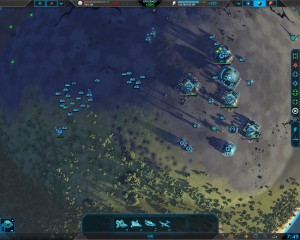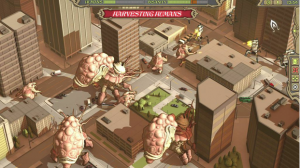I’ve wanted to talk more about Planetary Annihilation for awhile. Planetary Annihilation was the second big name success on Kickstarter following Doublefine with Broken Age and the Kickstarter seemed to be perfect for me: A Macro oriented Real Time Strategy game with one of the largest scales seen. The Kickstarter hit every one of its goals and had every indicator of being a success, but things didn’t happen that way. I barely played the game and it was released to a lot of poor to bad reviews.
For this post, I want to explore this further and why one of my most anticipated games failed so badly in the market.
Pricing and Funding:
We’re not going to be talking about gameplay in this post, as I went into that during my analysis of it last year ; instead I want to focus on the marketing and major decisions that hurt Planetary Annihilation in my opinion.
The first one has to do with funding and what happened after Kickstarter. Uber Entertainment followed the success of Kickstarter by putting Planetary Annihilation on Early Access and priced it at the same Kickstarter Tiers that were available during the campaign. This meant the game was first priced at $88 for people wanting to get into the Alpha, and over time it would drop down in price.
This annoyed the consumers on Steam who didn’t care that the game was a kickstarted project, but just saw an overpriced Alpha on the platform. They were trying to emulate Prison Architect who also started higher than normal, but they were only going for about $30, not $88. You really need to be careful with your pricing of a game and the developers were trying to have their cake and eat it too: They wanted kickstarter backers to not complain about pricing the game cheaper, but they also wanted more funding by going onto Early Access so early in the game’s development.
Klei Entertainment is the poster child for correct Early Access use; they went on the platform with titles that were already far into development and priced them as such. You were already going to get a great game with a Klei Early Access game, and they didn’t need the extra funding from Early Access to fund it. Prison Architect is once again the exception to these rules and honestly should not be followed by other developers as it was a very special case.

Klei Entertainment understands the early access market and knows how to pitch their titles and content on it
With Uber, they burnt a lot of goodwill and potential customers with this stunt, when they should have just waited before putting Planetary Annihilation out in front of a larger audience. This goes back to an important concept: Kickstarter backers are different from Steam consumers and you cannot treat the two as the same market.
Uber should have waited until Planetary Annihilation was in Beta and cheaper before going onto Early Access, that way the kickstarter fans would still have first dibs and the Steam community would be treated to a more refined title.
Early Release:
The next problem that faced Planetary Annihilation was that despite the funding and stretch goals, the game was still released early in terms of what was promised. One of the big goals was a persistent campaign called “Galactic War” which was supposed to be a full single player campaign for people not interested in the competitive side.
When the game was released the Galactic War mode was barely developed, full of bugs and broken concepts, and there was no save option. The developers had a flimsy excuse regarding the game’s required online connection to run and it took over a year after release before save game functionality was put in.
With the main content, people discovered that the promised of a challenging AI was also missing; as it did not understand how to use some of the more advanced options in the game. Several major unit types and options were also missing from the initial release, with Uber promising them at a later date. Again, enhancements and improvements did come, but far too late for the consumers expecting a quality product.

The UI and overall design of Planetary Annihilation was only aimed at the already hardcore fan base, with adjustments and enhancements scheduled for later
The game also had performance issues due to the high technical specifications required to play; you needed at least 8 gigs of RAM just to run things comfortably. Improvements were made to help computers run it but you guessed it, they didn’t come until after the game was released.
But the biggest problem for me and the people waiting for Planetary Annihilation had to do with the developers and making an unusual mistake: Listening to their fan base.
Not so Crowd Pleaser:
Planetary Annihilation was pitched as a new RTS that the developers could cultivate and grow without being tied to previous series and genre conventions. This would allow them to create an entirely original game that anyone could enjoy. Unfortunately what we got was a game that was tied to one group of players: The Hardcore.
Uber made a classic mistake of game development: Only listening to your hardcore fans when it comes to game design. Every aspect of the game was geared towards the hardcore: UI, game modes, design and balance and the AI. The UI was very barebones, because their fans already knew how things worked. There weren’t a lot of options to play the game, because their fans just wanted competitive play.

Human Resources was Uber’s second kickstarter project that they were banking on to succeed, but the response from Planetary Annihilation was harsh and sunk it
Of course listening to your fans is an important part of making a video game, but you need to make allowances for all skill levels and people playing.
Being able to design games for multiple skill groups is what companies like Nintendo and Blizzard have spent millions to develop. Blizzard especially as Starcraft 2 can be enjoyed by gamers of different skill levels, because they made allowances for them.
A hallmark of a great designer is being able to create content that works for multiple skill levels, without stepping on the toes of one particular group. Planetary Annihilation has never backed off from its hardcore appeal, in turn making it very inaccessible to new fans.
Nuked From Orbit:
As a conclusion to our story, Planetary Annihilation is still going along, but not at the pace Uber was hoping for. New additions to the game in terms of content have come very rarely, with the majority of patches being AI updates and bug fixes. The promise of continued development with new units features and game options have all but disappeared.
The clearest sign that Uber screwed up on their approach to Planetary Annihilation came shortly after the release, with the second kickstarter for a strategy game called Human Resources. While their first kickstarter was an amazing success, Human Resources did not come close to reaching their goals due to the reception of Planetary Annihilation.
Writing about Planetary Annihilation like this is sad, because this was one of my most anticipated titles that turned into the most disappointing. The big take away from this is understanding not just what your hardcore fans want, but what the market expects out of your game, because a niche experience rarely earns enough money for long term support.


